roof PEUGEOT 5008 2013 Owners Manual
[x] Cancel search | Manufacturer: PEUGEOT, Model Year: 2013, Model line: 5008, Model: PEUGEOT 5008 2013Pages: 364, PDF Size: 16.24 MB
Page 4 of 364
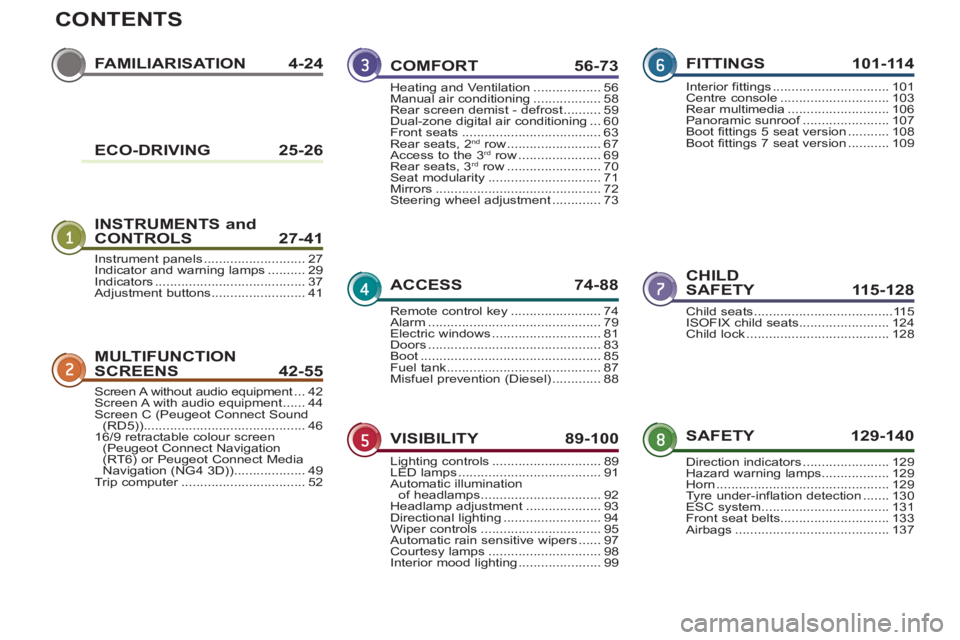
CONTENTS
FAMILIARISATION4-24
INSTRUMENTS and
CONTROLS 27-41
CHILD
SAFETY 115-128
MULTIFUNCTION
SCREEN
S42-55
SAFETY 129-140 COMFORT 56-7
3
ACCESS 74-88
VISIBILITY 89-100
FITTINGS 101-114
Instrument panels ...........................27Indicator and warning lamps ..........29Indicators........................................37Adjustment buttons.........................41
Child seats.....................................115ISOFIX child seats........................124Child lock......................................128
Screen A without audio equipment...t42Screen A with audio equipment......44Screen C (Peugeot Connect Sound (RD5))...........................................4616/9 retractable colour screen(Peugeot Connect Navigation (RT6) or Peugeot Connect Media
Navigation (NG4 3D))...................49Trip computer.................................r52
Direction indicators.......................129Hazard warning lamps..................129Horn..............................................129Tyre under-inflation detection .......130ESC system..................................131Front seat belts.............................133Airbags .........................................137
Heating and Ventilation ..................56Manual air conditioning ..................58Rear screen demist - defrost..........59Dual-zone digital air conditioning...60Front seats.....................................63Rear seats, 2nd row.........................67Access to the 3rdrow ......................69Rear seats, 3rdrow.........................70Seat modularity..............................71Mirrors............................................72Steering wheel adjustment .............73
Remote control key........................74Alarm..............................................79Electric windows.............................81Doors ..............................................83Boot................................................85Fuel tank.........................................87Misfuel prevention (Diesel).............88
Lighting controls.............................89LED lamps......................................91Automatic illumination
of headlamps................................92Headlamp adjustment ....................93Directional lighting..........................94Wiper controls................................95Automatic rain sensitive wipers ......97Courtesy lamps..............................98Interior mood lighting......................99
Interior fittings ...............................101Centre console .............................103Rear multimedia...........................106Panoramic sunroof.......................f107Boot fittings 5 seat version ...........108Boot fittings 7 seat version ...........109ECO-DRIVING 25-26
Page 5 of 364
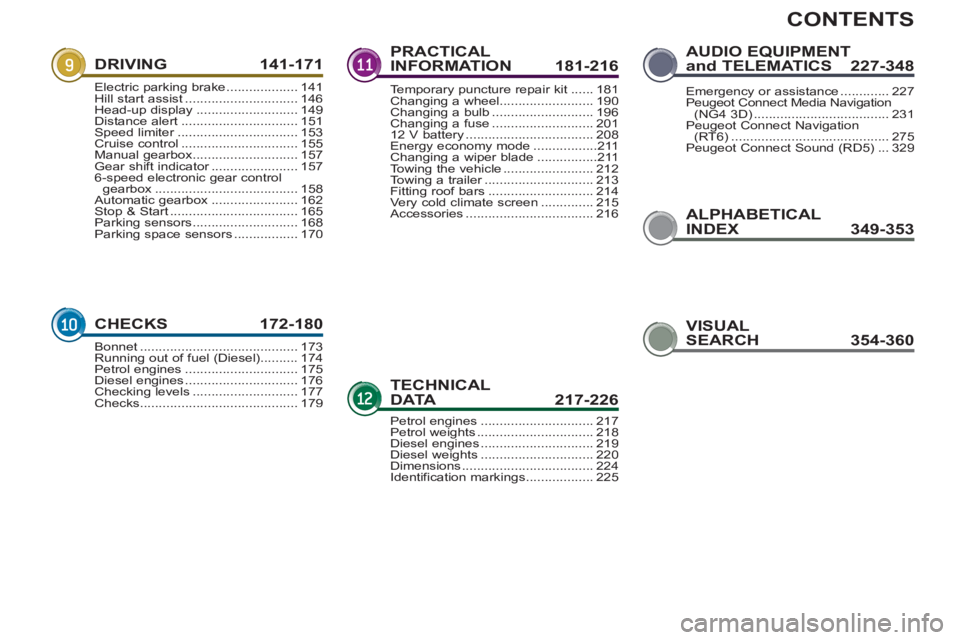
CONTENTS
ALPHABETICAL
INDEX349-353
DRIVING 141-171
CHECKS 172-180
PRACTICAL
INFORMATION 181-216
TECHNICAL DATA 217-226
AUDIO EQUIPMENTand TELEMATICS 227-348
Electric parking brake...................141Hill start assist..............................146Head-up display...........................149Distance alert ...............................151Speed limiter................................r153Cruise control...............................155Manual gearbox ............................157Gear shift indicator.......................r1576-speed electronic gear control gearbox......................................158Automatic gearbox.......................162Stop & Start ..................................165Parking sensors ............................168Parking space sensors.................170
Bonnet ..........................................173Running out of fuel (Diesel)..........174Petrol engines ..............................175Diesel engines..............................176Checking levels............................177Checks..........................................179
Temporary puncture repair kit......181Changing a wheel.........................190Changing a bulb...........................196Changing a fuse ...........................20112 V battery ..................................208Energy economy mode.................211Changing a wiper blade................211Towing the vehicle ........................212Towing a trailer.............................r213Fitting roof bars............................214Very cold climate screen..............215Accessories..................................216
Petrol engines..............................217Petrol weights...............................218Diesel engines ..............................219Diesel weights ..............................220Dimensions ...................................224Identification markings..................225
Emergency or assistance.............227Peugeot Connect Media Navigation (NG4 3D)....................................231Peugeot Connect Navigation(RT6) ..........................................275Peugeot Connect Sound (RD5)...329
VISUAL
SEARCH354-360
Page 6 of 364
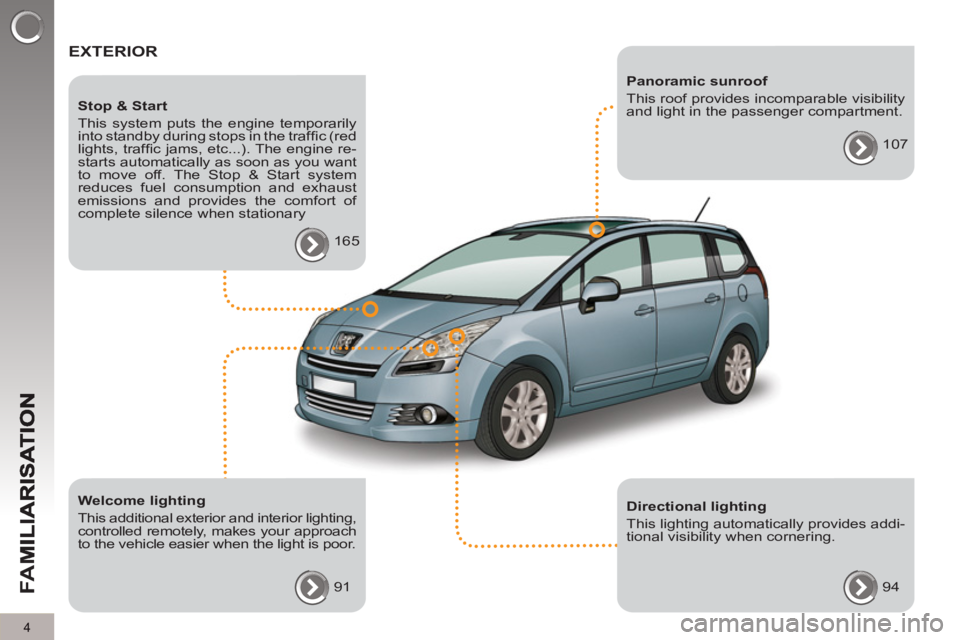
FA
M
4
EXTERIOR
Welcome lighting
This additional exterior and interior lighting,
controlled remotely, makes your approach
to the vehicle easier when the light is poor.
91
Stop & Start
This system puts the engine temporarily
into standby during stops in the traffi c (red
lights, traffi c jams, etc...). The engine re-
starts automatically as soon as you want
to move off. The Stop & Start system
reduces fuel consumption and exhaust
emissions and provides the comfort of
complete silence when stationary
165
Directional lighting
This lighting automatically provides addi-
tional visibility when cornering.
94
Panoramic sunroof
This roof provides incomparable visibility
and light in the passenger compartment.
107
Page 9 of 364
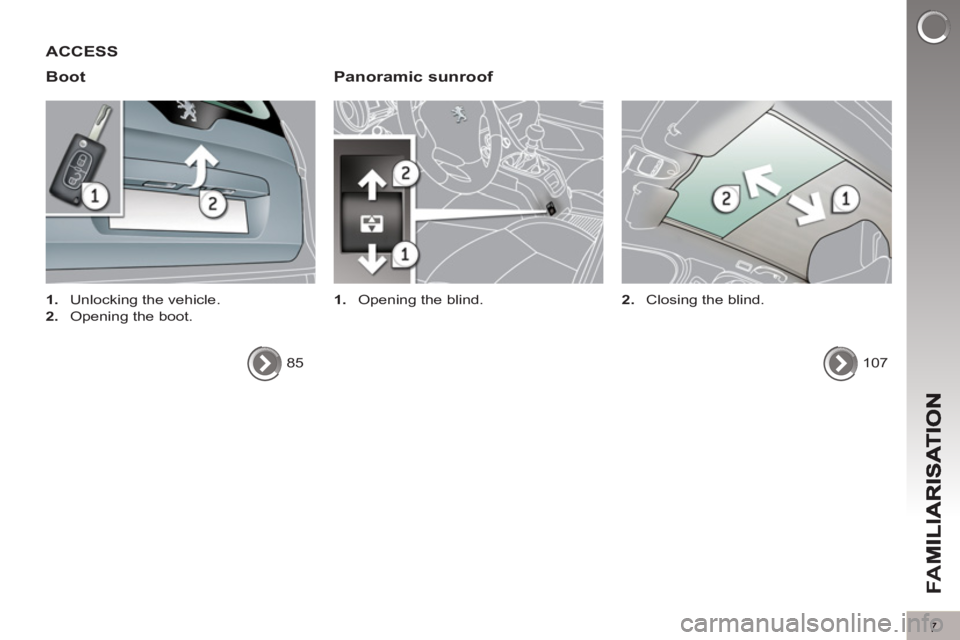
FA
M
7
ACCESS
Boot
Panoramic sunroof
1.
Opening the blind.
1.
Unlocking the vehicle.
2.
Opening the boot.
85
107
2.
Closing the blind.
Page 11 of 364
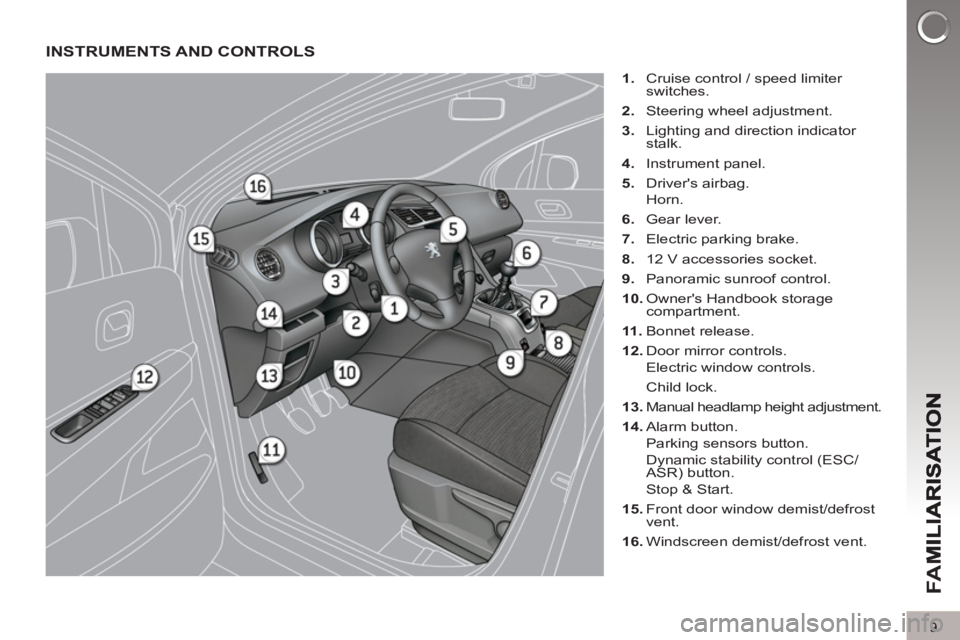
FA
M
9
INSTRUMENTS AND CONTROLS
1.
Cruise control / speed limiter
switches.
2.
Steering wheel adjustment.
3.
Lighting and direction indicator
stalk.
4.
Instrument panel.
5.
Driver's airbag.
Horn.
6.
Gear lever.
7.
Electric parking brake.
8.
12 V accessories socket.
9.
Panoramic sunroof control.
10.
Owner's Handbook storage
compartment.
11 .
Bonnet release.
12.
Door mirror controls.
Electric window controls.
Child lock.
13.
Manual headlamp height adjustment.
14.
Alarm button.
Parking sensors button.
Dynamic stability control (ESC/
ASR) button.
Stop & Start.
15.
Front door window demist/defrost
vent.
16.
Windscreen demist/defrost vent.
Page 27 of 364
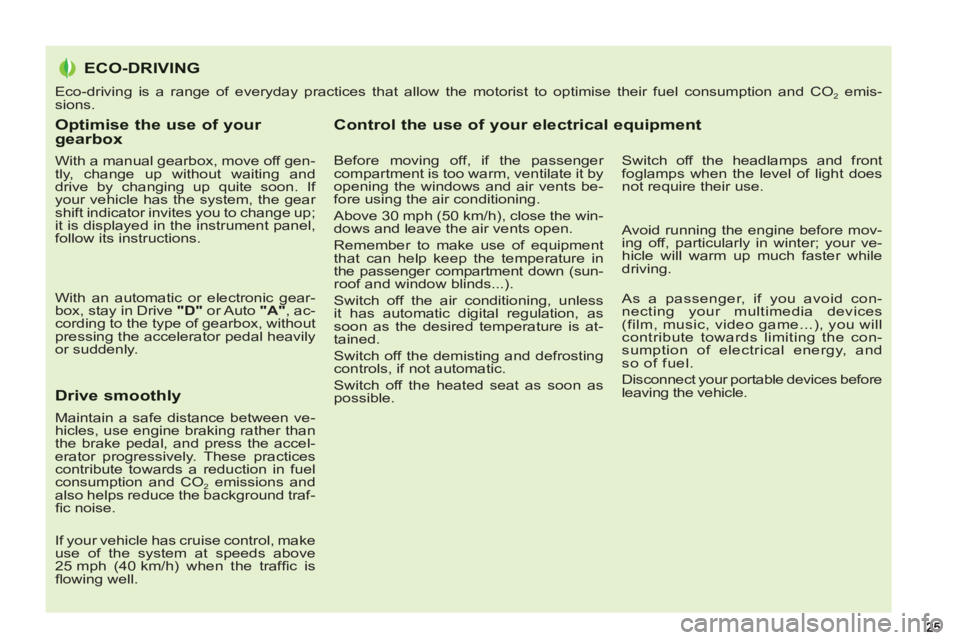
Optimise the use of your gearbox
With a manual gearbox, move off gen-
tly, change up without waiting and
drive by changing up quite soon. If
your vehicle has the system, the gear
shift indicator invites you to change up;
it is displayed in the instrument panel,
follow its instructions.
With an automatic or electronic gear-
box, stay in Drive "D"
or Auto "A"
, ac-
cording to the type of gearbox, without
pressing the accelerator pedal heavily
or suddenly.
Drive smoothly
Maintain a safe distance between ve-
hicles, use engine braking rather than
the brake pedal, and press the accel-
erator progressively. These practices
contribute towards a reduction in fuel
consumption and CO
2 emissions and
also helps reduce the background traf-
fi c noise.
If your vehicle has cruise control, make
use of the system at speeds above
25 mph (40 km/h) when the traffi c is
fl owing well.
Control the use of your electrical equipment
Before moving off, if the passenger
compartment is too warm, ventilate it by
opening the windows and air vents be-
fore using the air conditioning.
Above 30 mph (50 km/h), close the win-
dows and leave the air vents open.
Remember to make use of equipment
that can help keep the temperature in
the passenger compartment down (sun-roof and window blinds...).
Switch off the air conditioning, unless
it has automatic digital regulation, as
soon as the desired temperature is at-
tained.
Switch off the demisting and defrosting
controls, if not automatic.
Switch off the heated seat as soon as
possible.
Switch off the headlamps and front
foglamps when the level of light does
not require their use.
Avoid running the engine before mov-
ing off, particularly in winter; your ve-
hicle will warm up much faster while
driving.
As a passenger, if you avoid con-
necting your multimedia devices
(film, music, video game...), you will
contribute towards limiting the con-
sumption of electrical energy, and
so of fuel.
Disconnect your portable devices before
leaving the vehicle.
ECO-DRIVING
2525
Eco-driving is a range of everyday practices that allow the motorist to optimise their fuel consumption and CO2 emis-
sions.
Page 28 of 364
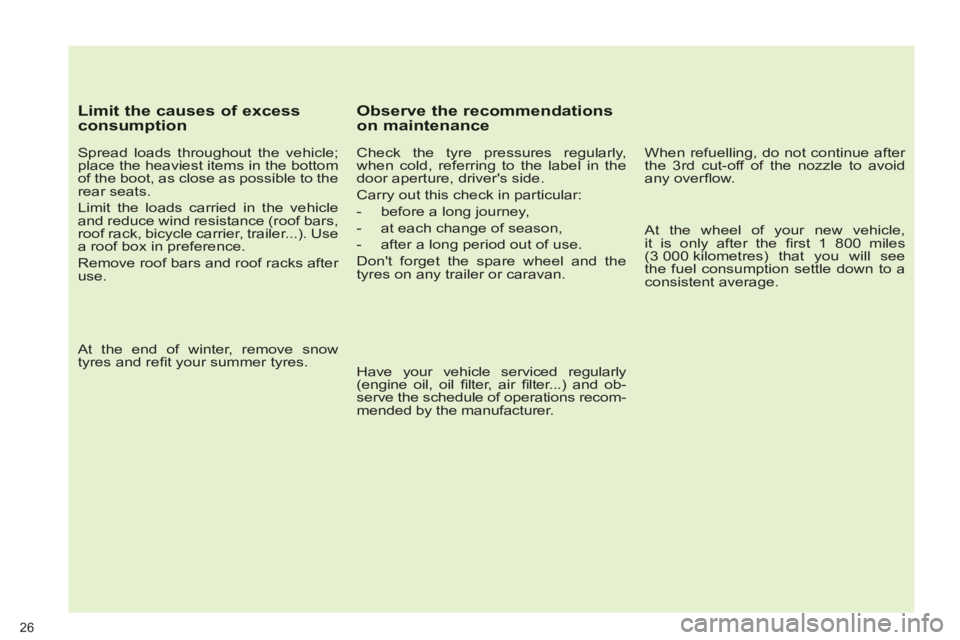
26
Limit the causes of excess consumption
Spread loads throughout the vehicle;
place the heaviest items in the bottom
of the boot, as close as possible to the
rear seats.
Limit the loads carried in the vehicle
and reduce wind resistance (roof bars,
roof rack, bicycle carrier, trailer...). Use
a roof box in preference.
Remove roof bars and roof racks after
use.
At the end of winter, remove snow
tyres and refi t your summer tyres.
Observe the recommendationson maintenance
Check the tyre pressures regularly,
when cold, referring to the label in the
door aperture, driver's side.
Carry out this check in particular:
- before a long journey,
- at each change of season,
- after a long period out of use.
Don't forget the spare wheel and the
tyres on any trailer or caravan.
Have your vehicle serviced regularly
(engine oil, oil fi lter, air fi lter...) and ob-
serve the schedule of operations recom-
mended by the manufacturer.
When refuelling, do not continue after
the 3 rd cut-off of the nozzle to avoid
any overfl ow.
At the wheel of your new vehicle,
it is only after the fi rst 1 800 miles
(3 000 kilometres) that you will see
the fuel consumption settle down to a
consistent average.
Page 109 of 364
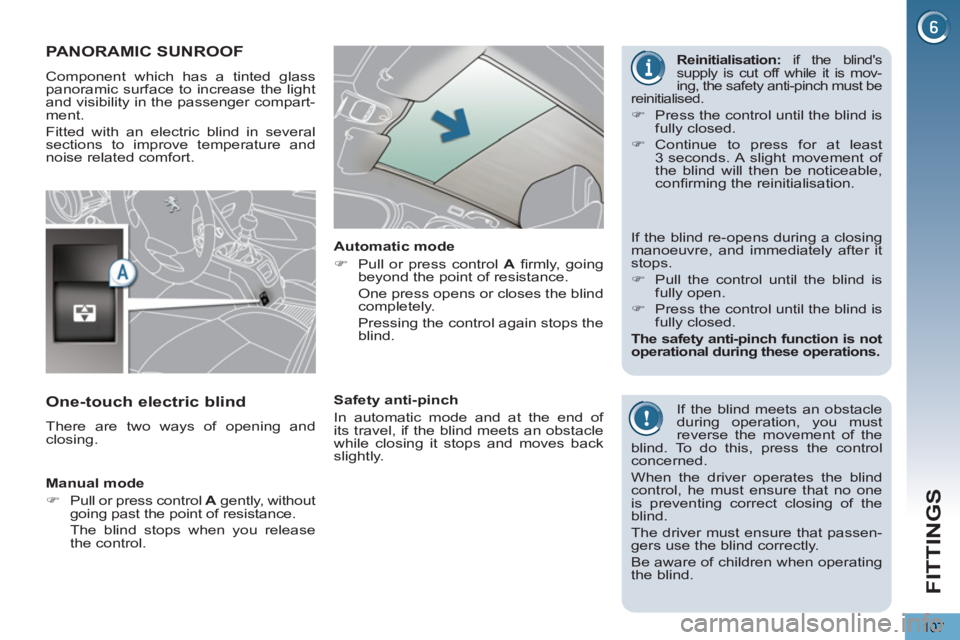
FITTINGS
107
PANORAMIC SUNROOF
Component which has a tinted glass
panoramic surface to increase the light
and visibility in the passenger compart-
ment.
Fitted with an electric blind in several
sections to improve temperature and
noise related comfort.
If the blind meets an obstacle
during operation, you must
reverse the movement of the
blind. To do this, press the control
concerned.
When the driver operates the blind
control, he must ensure that no one
is preventing correct closing of the
blind.
The driver must ensure that passen-
gers use the blind correctly.
Be aware of children when operating
the blind.
Manual mode
�)
Pull or press control A
gently, without
going past the point of resistance.
The blind stops when you release
the control.
Automatic mode
�)
Pull or press control A
fi rmly, going
beyond the point of resistance.
One press opens or closes the blind
completely.
Pressing the control again stops the
blind.
Safety anti-pinch
In automatic mode and at the end of
its travel, if the blind meets an obstacle
while closing it stops and moves back
slightly.
One-touch electric blind
There are two ways of opening and
closing.
If the blind re-opens during a closing
manoeuvre, and immediately after it
stops.
�)
Pull the control until the blind is
fully open.
�)
Press the control until the blind is
fully closed.
The safety anti-pinch function is not
operational during these operations.
Reinitialisation:
if the blind's
supply is cut off while it is mov-
ing, the safety anti-pinch must be
reinitialised.
�)
Press the control until the blind is
fully closed.
�)
Continue to press for at least
3 seconds. A slight movement of
the blind will then be noticeable,
confi rming the reinitialisation.
Page 113 of 364
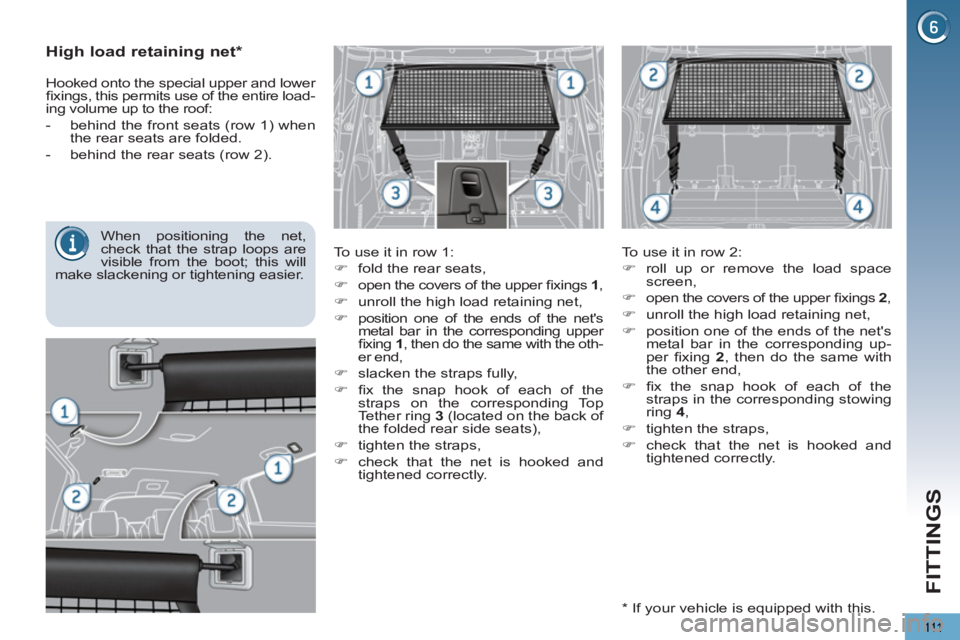
FITTINGS
111
High load retaining net *
To use it in row 1:
�)
fold the rear seats,
�)
open the covers of the upper fi xings 1
,
�)
unroll the high load retaining net,
�)
position one of the ends of the net's
metal bar in the corresponding upper
fi xing 1
, then do the same with the oth-
er end,
�)
slacken the straps fully,
�)
fi x the snap hook of each of the
straps on the corresponding Top
Tether ring 3
(located on the back of
the folded rear side seats),
�)
tighten the straps,
�)
check that the net is hooked and
tightened correctly.
To use it in row 2:
�)
roll up or remove the load space
screen,
�)
open the covers of the upper fi xings 2
,
�)
unroll the high load retaining net,
�)
position one of the ends of the net's
metal bar in the corresponding up-
per fi xing 2
, then do the same with
the other end,
�)
fi x the snap hook of each of the
straps in the corresponding stowing
ring 4
,
�)
tighten the straps,
�)
check that the net is hooked and
tightened correctly.
When positioning the net,
check that the strap loops are
visible from the boot; this will
make slackening or tightening easier.
Hooked onto the special upper and lower
fi xings, this permits use of the entire load-
ing volume up to the roof:
- behind the front seats (row 1) when
the rear seats are folded.
- behind the rear seats (row 2).
*
If your vehicle is equipped with this.
Page 137 of 364
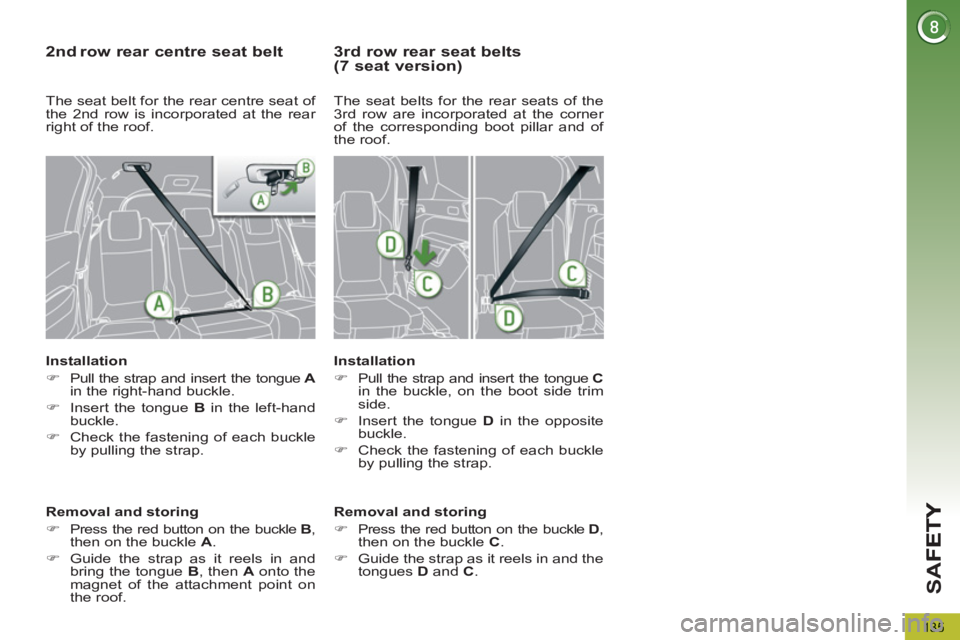
SA
F
135
2 ndrow rear centre seat belt
Installation
�)
Pull the strap and insert the tongue A
in the right-hand buckle.
�)
Insert the tongue B
in the left-hand
buckle.
�)
Check the fastening of each buckle
by pulling the strap.
Removal and storing
�)
Press the red button on the buckle B
,
then on the buckle A
.
�)
Guide the strap as it reels in and
bring the tongue B
, then A
onto the
magnet of the attachment point on
the roof.
3 rd row rear seat belts(7 seat version)
Installation
�)
Pull the strap and insert the tongue C
in the buckle, on the boot side trim
side.
�)
Insert the tongue D
in the opposite
buckle.
�)
Check the fastening of each buckle
by pulling the strap.
The seat belts for the rear seats of the
3
rd row are incorporated at the corner
of the corresponding boot pillar and of
the roof.
Removal and storing
�)
Press the red button on the buckle D
,
then on the buckle C
.
�)
Guide the strap as it reels in and the
tongues D
and C
.
The seat belt for the rear centre seat of
the 2 nd row is incorporated at the rear
right of the roof.